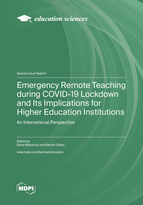Emergency Remote Teaching during COVID-19 Lockdown and Its Implications for Higher Education Institutions: An International Perspective
A special issue of Education Sciences (ISSN 2227-7102). This special issue belongs to the section "Higher Education".
Deadline for manuscript submissions: closed (30 November 2022) | Viewed by 39853
Special Issue Editors
Interests: acculturation and cultural identity; school adjustment of immigrant and minority youth; school dropout; values in school education; gender disparities in a school context; career choice and career education; digital tools in education
Special Issues, Collections and Topics in MDPI journals
Interests: intercultural and interlingual teaching/learning processes; development of intercultural expertise in schools and in teaching; reflective competences in teacher education; migration and school engagement; digital teaching in education
Special Issue Information
Dear Colleagues,
In spring 2020, the COVID-19 virus and subsequent lockdown demanded that university institutions across the globe undertake an emergency migration to online teaching. To secure the continuation of university teaching, Emergency Remote Teaching (Bozkurt and Ramesh, 2020)—prompt rethinking and adjustment among university teachers—had to be managed. On the one hand, this abrupt change is associated with a certain digital and pedagogical potential for change due to the necessary adaptation efforts. On the other hand, it also poses an extraordinary organisational and pedagogical challenge. From an empirical perspective, it is therefore crucial to ask how university teachers and universities are tackling the coronavirus situation against the backdrop of the goal to maintain high-quality teaching. Furthermore, the adjustment and well-being of students in the context of hybrid and distance learning situations must remain in focus.
The aim of this Special Issue is to provide unique insights into organisational, pedagogical, and psychological challenges related to digital transition in Higher Education institutions in different countries resulting from university lockdowns during the COVID-19 pandemic. It also discusses digital and pedagogical potentials evolving through the adaptation efforts related to the situation of Emergency Remote Teaching at universities.
Both Guest Editors contributed equally to the release of this special issue.
We look forward to receiving your contributions.
Prof. Dr. Elena Makarova
Prof. Dr. Kerstin Göbel
Guest Editors
Manuscript Submission Information
Manuscripts should be submitted online at www.mdpi.com by registering and logging in to this website. Once you are registered, click here to go to the submission form. Manuscripts can be submitted until the deadline. All submissions that pass pre-check are peer-reviewed. Accepted papers will be published continuously in the journal (as soon as accepted) and will be listed together on the special issue website. Research articles, review articles as well as short communications are invited. For planned papers, a title and short abstract (about 100 words) can be sent to the Editorial Office for announcement on this website.
Submitted manuscripts should not have been published previously, nor be under consideration for publication elsewhere (except conference proceedings papers). All manuscripts are thoroughly refereed through a double-blind peer-review process. A guide for authors and other relevant information for submission of manuscripts is available on the Instructions for Authors page. Education Sciences is an international peer-reviewed open access monthly journal published by MDPI.
Please visit the Instructions for Authors page before submitting a manuscript. The Article Processing Charge (APC) for publication in this open access journal is 1800 CHF (Swiss Francs). Submitted papers should be well formatted and use good English. Authors may use MDPI's English editing service prior to publication or during author revisions.
Keywords
- COVID-19 lockdown
- emergency remote teaching
- higher education
- teachers
- students







